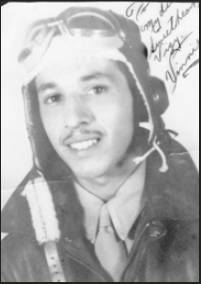B-24 bomber badly shot up on flight over Berlin

Vincent Durand of Port Charlotte, Fla. holds a copy of the local newspaper that says it all: “SURRENDER SIGNED!” This picture was taken at an air base near Madison, Wis., after he returned from his tour with the 8th Air Force in England during World War II. Photo provided
Buried in a box of old pictures and military records tucked away in a chest of drawers in Vincent Durand’s Port Charlotte, Fla. home is a medal from long ago.
The bronze medal with its four-bladed airplane propeller was attached to a red, white and blue ribbon — The Distinguished Flying Cross.
The 83-year-old former Air Force sergeant who served as a radio operator and upper turret gunner aboard a B-24 “Liberator” in World War II received the commendation for one of the three flights the crew of “Brown Knoser” made to Berlin.
It was awarded: “For heroism or extraordinary achievement while participating in an aerial flight.”
Although Durand is a bit fuzzy about all the details of his experiences during the Second World War, he distinctly remembers the flight to Berlin when his B-24 got all shot up.
Hundreds of American bombers flew in formation from their bases in England on an eight hour flight into the heart of Germany on a mission of mass distruction.
It was led by Jimmy Stewart, who even then was an award-winning Hollywood actor.
“After our fighter escorts dropped off before we reached Berlin we were attacked by enemy ME-109 fighters. All of a sudden a member of the crew screamed into the plane’s intercom: ‘Enemy, enemy on the right or left,” Durand said more than 60 years later.

Vincent Durand holds the Distinguished Flying Cross he received for a particularly hazardous flight over Berlin as a top turret gunner on a B-24 bomber during World War II. Sun photo by Don Moore
“The German fighters came at us from all sides. I started shooting at them with my twin 50s,” he said. “I think I got one, but I wasn’t sure, so I didn’t try and claim it.
“One man in our plane named Malone from Long Island actually shot a fighter plane down. He claimed it because everyone saw it go down.
“We had just dropped our bombs over Berlin when our B-24 was hit by flak that knocked out and engine on both wings. I can’t remember which ones because it’s such a long time ago,” Durand said.
“I remember we began to lose altitude and had to drop out of formation while still over Berlin. When we did, a buddy of Capt. Brown, our pilot, dropped out of formation with us as we flew through a cloud bank. The other bomber followed us all the way back to France.”
They were lucky, they weren’t attacked by German fighters on the return flight. This is when enemy fighters shot down lots of damaged American bombers attempting to limp back to base on a couple of engines.
Capt. Brown and his crippled four-engine heavy bomber and crew of 10 were coming back to their base near Bunjay, England, low and slow on a wing and a prayer. They arrived home hours behind schedule.
“There were holes all over the plane from enemy anti-aircraft flak. Both wings were full of holes and so were the body and the tail,” he said. “I don’t know if the plane ever flew again or not.”
The crew of “Brown Knoser” was lucky that day, none of them received a scratch from enemy fire during their mission to Berlin.
By the time Durand and his flying buddies returned to their barracks, the stuff in their foot lockers had been divided up among their bunkmates. It was standard operating procedure.
“All of the guys in the barracks were glad to have us back,” Durand said. “One by one they’d come up to us and say, ‘Here’s your shirt, here’s your pants’ and so on. I never lost a thing.”
What was bothering the crew of “Brown Knoser” was the flight to Berlin was their 25th mission and what was supposed to be their last until the bomber crew was given another five flights.
“We were all scared we might be shot down during one of the last five flights. We’d seen other bombers shot down in flames and we weren’t happy about it,” he said.
“Brown Knoser’s” crew survived the war and came home all in one piece.
Durand arrived back in New York City aboard a transport ship before V-E Day, May 8, 1945, when Germany surrendered to Allied forces.
He spent the last few months of the war teaching young airmen how to survive air combat.
On Oct. 16, 1945, he was discharged. He came marching home to his wife, Virginia, at 31 Sands St., Brooklyn, N.Y., near the Brooklyn Navy Yard.

Vincent Durand sent a copy of his boot camp graduation picture to his sweetheart “Bigy” back in Brooklyn. He was 18 years old in 1943 when this picture was taken. Photo provided
His commendations
Former T-Sgt. Vincent Durand of Port Charlotte flew 30 missions as a radio operator and top turret gunner aboard a B-24 “Liberator” bomber over Nazi occupied Europe in World War II.
He received The Distinguished Flying Cross for heroism and four Air Medals for the 30 combat missions he flew.
This story was first published in the Charlotte Sun newspaper, Port Charlotte, Fla. on Monday, Dec. 18, 2006 and is republished with permission.
All rights reserved. This copyrighted material may not be republished without permission. Links are encouraged.
Click here to view the War Tales fan page on FaceBook.
Vincent Durand was born 10 January 1923 and died 9 September 2007 at the age of 84. Durand is buried in Restlawn Memorial Gardens, Port Charlotte, Fla.